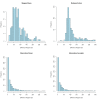Prevalence of alternative splicing choices in Arabidopsis thaliana
- PMID: 20525311
- PMCID: PMC3017808
- DOI: 10.1186/1471-2229-10-102
Prevalence of alternative splicing choices in Arabidopsis thaliana
Abstract
Background: Around 14% of protein-coding genes of Arabidopsis thaliana genes from the TAIR9 genome release are annotated as producing multiple transcript variants through alternative splicing. However, for most alternatively spliced genes in Arabidopsis, the relative expression level of individual splicing variants is unknown.
Results: We investigated prevalence of alternative splicing (AS) events in Arabidopsis thaliana using ESTs. We found that for most AS events with ample EST coverage, the majority of overlapping ESTs strongly supported one major splicing choice, with less than 10% of ESTs supporting the minor form. Analysis of ESTs also revealed a small but noteworthy subset of genes for which alternative choices appeared with about equal prevalence, suggesting that for these genes the variant splicing forms co-occur in the same cell types. Of the AS events in which both forms were about equally prevalent, more than 80% affected untranslated regions or involved small changes to the encoded protein sequence.
Conclusions: Currently available evidence from ESTs indicates that alternative splicing in Arabidopsis occurs and affects many genes, but for most genes with documented alternative splicing, one AS choice predominates. To aid investigation of the role AS may play in modulating function of Arabidopsis genes, we provide an on-line resource (ArabiTag) that supports searching AS events by gene, by EST library keyword search, and by relative prevalence of minor and major forms.
Figures







Similar articles
-
Detection and prediction of alternative splicing in Arabidopsis thaliana.Int J Comput Biol Drug Des. 2008;1(1):39-58. doi: 10.1504/ijcbdd.2008.018709. Int J Comput Biol Drug Des. 2008. PMID: 20055000
-
Alternative splicing at NAGNAG acceptors in Arabidopsis thaliana SR and SR-related protein-coding genes.BMC Genomics. 2008 Apr 10;9:159. doi: 10.1186/1471-2164-9-159. BMC Genomics. 2008. PMID: 18402682 Free PMC article.
-
Comprehensive analysis of alternative splicing in rice and comparative analyses with Arabidopsis.BMC Genomics. 2006 Dec 28;7:327. doi: 10.1186/1471-2164-7-327. BMC Genomics. 2006. PMID: 17194304 Free PMC article.
-
Arabidopsis genomic information for interpreting wheat EST sequences.Funct Integr Genomics. 2003 Mar;3(1-2):33-8. doi: 10.1007/s10142-002-0075-1. Epub 2002 Sep 5. Funct Integr Genomics. 2003. PMID: 12590341 Review.
-
How prevalent is functional alternative splicing in the human genome?Trends Genet. 2004 Feb;20(2):68-71. doi: 10.1016/j.tig.2003.12.004. Trends Genet. 2004. PMID: 14746986 Review.
Cited by
-
Enhanced Salt Tolerance Conferred by the Complete 2.3 kb cDNA of the Rice Vacuolar Na(+)/H(+) Antiporter Gene Compared to 1.9 kb Coding Region with 5' UTR in Transgenic Lines of Rice.Front Plant Sci. 2016 Jan 25;7:14. doi: 10.3389/fpls.2016.00014. eCollection 2016. Front Plant Sci. 2016. PMID: 26834778 Free PMC article.
-
Genome-wide landscape of alternative splicing events in Brachypodium distachyon.DNA Res. 2013 Apr;20(2):163-71. doi: 10.1093/dnares/dss041. Epub 2013 Jan 7. DNA Res. 2013. PMID: 23297300 Free PMC article.
-
RNA G-Quadruplexes in the model plant species Arabidopsis thaliana: prevalence and possible functional roles.Nucleic Acids Res. 2010 Dec;38(22):8149-63. doi: 10.1093/nar/gkq804. Epub 2010 Sep 21. Nucleic Acids Res. 2010. PMID: 20860998 Free PMC article.
-
Identification of cytokinin-responsive genes using microarray meta-analysis and RNA-Seq in Arabidopsis.Plant Physiol. 2013 May;162(1):272-94. doi: 10.1104/pp.113.217026. Epub 2013 Mar 22. Plant Physiol. 2013. PMID: 23524861 Free PMC article.
-
Anno genominis XX: 20 years of Arabidopsis genomics.Plant Cell. 2021 May 31;33(4):832-845. doi: 10.1093/plcell/koaa038. Plant Cell. 2021. PMID: 33793861 Free PMC article. Review.
References
-
- Cline MS, Shigeta R, Wheeler RL, Siani-Rose MA, Kulp D, Loraine AE. The effects of alternative splicing on transmembrane proteins in the mouse genome. Pac Symp Biocomput. 2004. pp. 17–28. - PubMed
Publication types
MeSH terms
LinkOut - more resources
Full Text Sources
Research Materials

